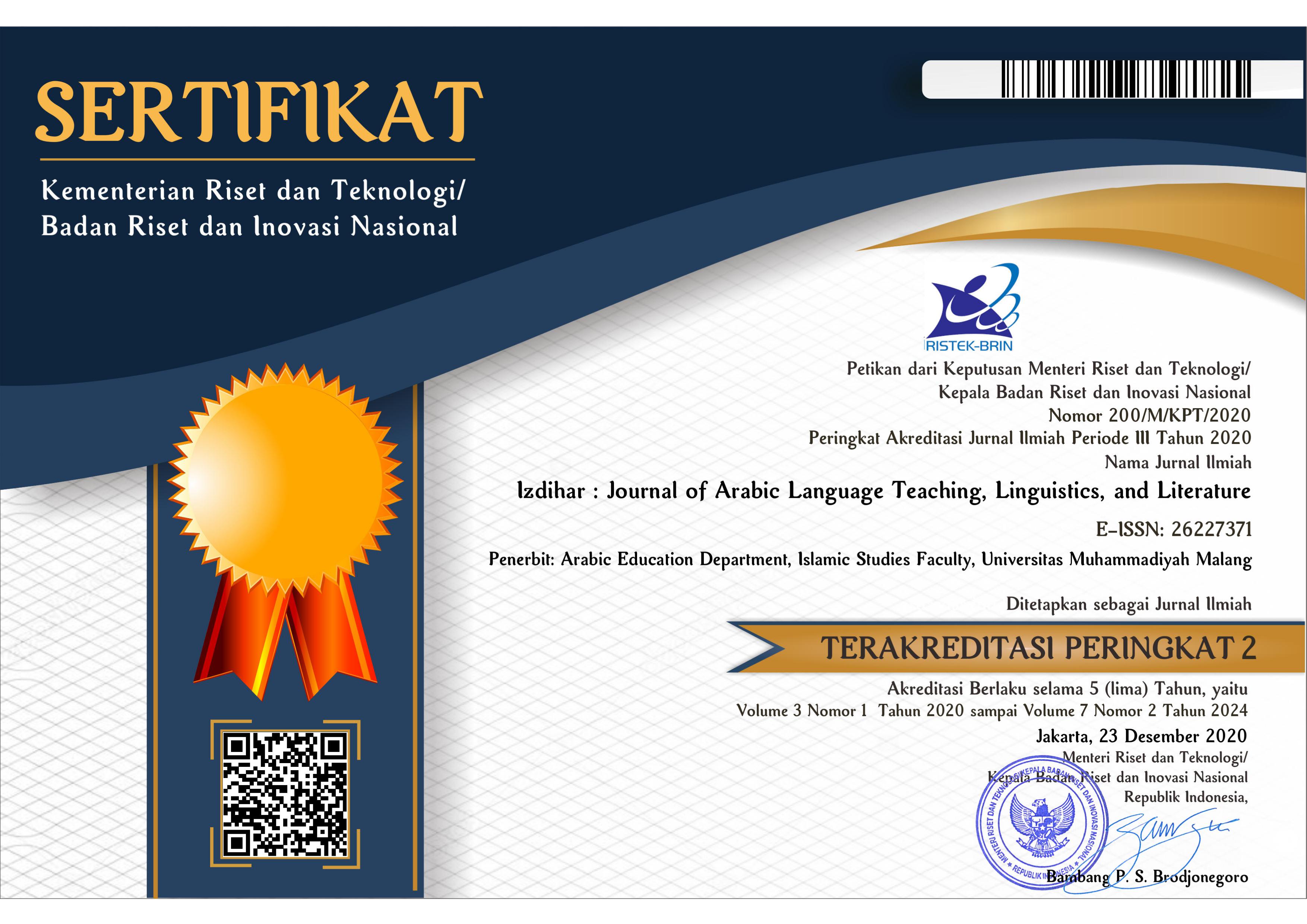Learning Arabic Translation at Islamic Boarding School in Madura
DOI:
https://doi.org/10.22219/jiz.v2i3.10578Keywords:
Arabic Language, Ma’had Al-Amin, TranslationAbstract
The study aimed to describe the method of learning turats book with a translation model in al-Amin Islamic boarding schools. This research was conducted using a qualitative approach with the process of analysis deductively. The process of data retrieval was based on direct observation of the learning process in Ma’had Al-Amin. The results of this study were the process of learning turats book material using the Harfiyah translation or literal translation process. The learning process is supported by the existence of “syamil” book which contains of material on qawaid. With the existence of the book, students were able to translate books containing subject matter with the help of the book of syamil. Therefore, the purpose of learning can be directly conveyed and students' understanding of qawaid translation if it can be done outside the classroom.
Downloads
References
Abdullah, R. (2012). Pembelajaran Berbasis Pemanfaatan Sumber Belajar. Jurnal Ilmiah Didaktika: Media Ilmiah Pendidikan dan Pengajaran, 12(2). DOI: http://dx.doi.org/10.22373/jid.v12i2.449
Pradini, N. A. (2016). Metode Floor Time Terhadap Penambahan Kosakata Anak Autis di SLB. Jurnal Pendidikan Khusus, 7(4).
Arif, M. (2019). Metode Langsung (Direct Method) dalam Pembelajaran Bahasa Arab. Al-Lisan: Jurnal Bahasa (e-Journal), 5(1), 44-56. DOI: https://doi.org/10.30603/al.v4i1.605
Asy’ari, H., & Zainuddin, A. (2018). Ta'lim al-Lughah al-'Arabiyyah fi al-Ma'had al-Salafy wa al-Ma'had al-Hadits Namadzijan. Izdihar: Journal of Arabic Language Teaching, Linguistics, and Literature, 1(2). DOI: https://doi.org/10.22219/izdihar.v1i2.7298
Badar, A. (1982). Ushul Al-Bahts Al-Ilmi wa Manahijuhu. Kuwait: Wakalah Al-Mathbuu'at 'Abdullah Hirmi.
Badawi, A. R. (1963). Manahij Al-Bahts Al-'Ilmi. Kairo: Daar An-nahdhoh Al-'Arabiyyah.
Baharun, H. (2016). Penilaian Berbasis Kelas pada Pembelajaran Pendidikan Agama Islam di Madrasah. Modeling: Jurnal Program Studi PGMI, 3(2), 204-216. DOI: https://doi.org/10.36835/modeling.v3i2.82
Budianto, L. (2010). A practical guide for translation skill: UIN-Maliki Press.
Darma, Y. A. (2007). Metode Pembelajaran Penerjemahan. Jurnal Pendidikan dan Kebudayaan, 13(67), 678-695. DOI: https://dx.doi.org/10.24832/jpnk.v13i67.391
Didawi, M. (1992). 'Ilmu Tarjamah Baina Nadhoriyyah wa At-Tathbiiq. Tunis: Daar Al-Maa'rif As-Salsalah.
Efendi, A. (2009). Beberapa Catatan tentang Buku Teks Pelajaran di Sekolah. INSANIA: Jurnal Pemikiran Alternatif Kependidikan, 14(2), 320-333. DOI: https://doi.org/10.24090/insania.v14i2.334
Fadil, M. (2016). Nalar Eksklusif Penafsiran Al-Qur’an Studi Terjemah Depag dan Tarjamah Tafsiriyah. JOURNAL OF QUR'AN AND HADITH STUDIES, 5(2), 123-150. DOI: https://doi.org/10.1548/quhas.v5i2.13422
Furqon, M. R., & Fauzi, M. F. (2019). The Values of Educational Character in the Arabic Temples of Qasidah Burdah by Imam Bushiri. Izdihar: Journal of Arabic Language Teaching, Linguistics, and Literature, 2(1), 67–76. DOI: https://doi.org/10.22219/jiz.v2i1.8327
Hakim, A. a. M. A. (1989). 'Ilmu Tarjamah An-Nadhory. Damaskus: Thullas Li Addirosaat wa tarjamah wa An-Nasyar.
Hanun, A., & Wassalwa, A. (2017). Problematika Implementasi Qowaid Al-Lughah dalam Membaca Kitab Kuning di Madrasah Ta'hiliyah Ibrahimy. Lisan al-Hal: Jurnal Pengembangan Pemikiran dan Kebudayaan, 11(1), 87-104.
Hidayat, N. S. (2012). Problematika Pembelajaran Bahasa Arab. An-Nida', 37(1), 82-88.
Katfuru (Ed.). (1991). Nadhoriyyah Lughowiyyah Fi At-Tarjamah. Bairut: Daar AL-Kutuub Al-Wathoniyyah.
Lubis, I. (2004). Ihwal Penerjemahan Bahasa Arab ke dalam Bahasa Indonesia. Humaniora, 16(1), 96-104. DOI: https://doi.org/10.22146/jh.810
Ma'luf, L. (2005). Almunjid Fi Allughoh Aa Al-A'alam. bairut: Dar Al-Masyraq.
Machali, R. (2000). Pedoman bagi Penerjemah. Jakarta: PT. Grasindo.
Muhammad, M. (2018). Dinamika Terjemah Al-Qur'an (Studi Perbandingan Terjemah Al-Qur'an Kementerian Agama RI dan Muhammad Thalib). Jurnal Studi Ilmu-ilmu Al-Qur'an dan Hadis, 17(1), 1-24. DOI: https://doi.org/10.14421/qh.2016.1701-01
Mularsih, H. (2007). Pembelajaran Individual dengan Menggunakan Modul. Pembelajaran Individual dengan Menggunakan Modul, 9(1), 1-17.
Munday, J. (2012). Introducing Translation Studies Theories and Applications. New York: Taylor and Francis Group.
Prasetyo, J. (2011). Analisis Transposisi dan Modulasi pada Buku Teori Budaya Terjemahan dari Buku Culture Theory. Lingua, 7(1).
Qodri, M. (2019). Arabic Language Test in the Perspective of Competency-Based Curriculum for Students of Madrasah Aliyah Negeri 3 Malang. Izdihar: Journal of Arabic Language Teaching, Linguistics, and Literature, 2(2), 115-134. DOI: https://doi.org/10.22219/jiz.v2i2.10003
Rahardjo, M. (2010). Triangulasi dalam Penelitian Kualitatif. Malang: Unpublished Paper.
Shobaruddin, H. (2019). Penterjemahan Kitab Kuning di Pesantren (Studi Kasus di Pondok Pesantren Al-Anwar Kuningan). Syntax Literate; Jurnal Ilmiah Indonesia, 4(6), 63-70.
Sholih, S. i. I. (2007). Tarjamah An-Nusush Al-Islaamiyyah Al-Muqoddasah. Riyadh: Kitab 'Arabiyyah.
Suciati, E. (2010). Penerjemah dan Penelitian Terjemahan. Diglossia: Jurnal Kajian Ilmiah Kebahasaan dan Kesusastraan, 1(2). doi: http://dx.doi.org/10.26594/diglossia.v1i2.77
Suryawinata, Z., & Hariyanto, S. (2003). Translation Bahasan Teori & Penuntun Praktis Menerjemah: Kanisius.
Syahatah, H. (1996). Ta'liim Lughoh Al-'Arabiyah Baina Nadhaoriyyah Wa At-Tathbiiq. Kairo: Ad-Daar Al-Mishriyyah Al-Bananiyyah.
Widiarti, R. (2011). Analisis Penerjemahan Metafora: Studi Kasus Metafora Dalam Novel Yukiguni Karya Kawabata Yasunari Dan Terjemahannya Daerah Salju Oleh Ajip Rosidi. Lingua Cultura, 5(2), 180-186. DOI: https://doi.org/10.21512/lc.v5i2.388
Widyamartaya, A. (1989). Seni menerjemahkan. Yogyakarta: Kanisius.
Wiyanti, E. (2015). Peran Minat Membaca dan Penguasaan Kosakata terhadap Keterampilan Berbicara Bahasa Indonesia. DEIKSIS, 6(02), 89-100. DOI: http://dx.doi.org/10.30998/deiksis.v6i02.519
Downloads
Published
How to Cite
Issue
Section
License
Copyright Notice
Authors who publish with this journal agree to the following terms:
- Authors retain copyright and grant the journal right of first publication with the work simultaneously licensed under a Creative Commons Attribution-ShareAlike 4.0 International License that allows others to share the work with an acknowledgment of the work's authorship and initial publication in this journal.
- Authors are able to enter into separate, additional contractual arrangements for the non-exclusive distribution of the journal's published version of the work (e.g., post it to an institutional repository or publish it in a book), with an acknowledgment of its initial publication in this journal.
- Authors are permitted and encouraged to post their work online (e.g., in institutional repositories or on their website) prior to and during the submission process, as it can lead to productive exchanges, as well as earlier and greater citation of published work (See The Effect of Open Access).
Copyright (c) 2019 Izdihar : Journal of Arabic Language Teaching, Linguistics, and Literature

This work is licensed under a Creative Commons Attribution-ShareAlike 4.0 International License.

















